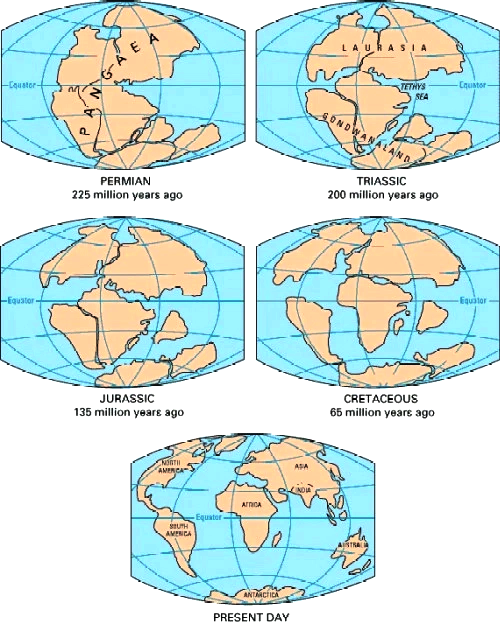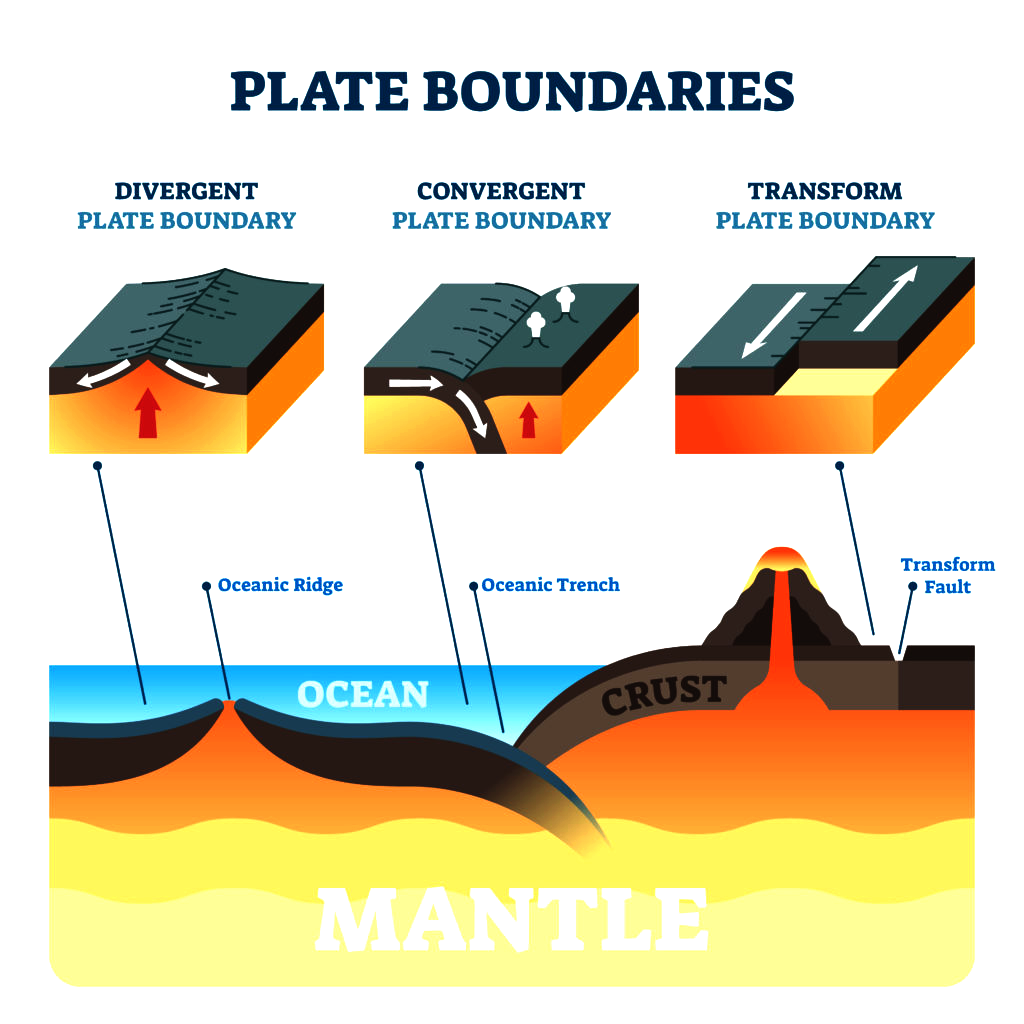Formation of Continents | 16 Aug 2022
For Prelims: Continental Drift, Plate Tectonics Theory
For Mains: Continent Formation, Continental Drift and Plate Tectonics Theory
Why in News?
According to a new study, the earth’s continents were formed by massive meteorite impacts that were prevalent during the first billion years of our planet’s four and a half billion-year history.
What are the Highlights of the Study?
- About:
- Meteorite impacts generated massive energy to form oceanic plates, which later evolved into continents.
- The theory that giant meteorite impacts formed continents had been around for decades, but until now, there was little solid evidence for its support.
- The Current theory is the most commonly accepted theory in place that attributes continent formation to the movement of tectonic plates.
- Evidence for Meteorite Impact Theory:
- Zircon crytals in Pilbara Craton: The researchers looked for evidence in zircon crystals embedded in rocks from the Pilbara Craton in Western Australia. This craton is the remnant of an ancient crust that began forming more than three billion years ago.
- Zircons are formed by the crystallisation of magma or are found in metamorphic rocks.
- They act as tiny time capsules, recording the period of geologic activity. Newer zircon adds to the original crystal as time progresses.
- The study of the variants or isotopes of oxygen within these crystals i.e., oxygen-18 and oxygen-16 and their ratio helped to estimate past temperatures.
- Older grains of zircon possessed the lighter oxygen-16. The younger ones contained the heavier oxygen-18.
- Cratons: A craton is an old and stable part of the continental lithosphere, which consists of Earth’s two topmost layers, the crust and the uppermost mantle.
- Zircon crytals in Pilbara Craton: The researchers looked for evidence in zircon crystals embedded in rocks from the Pilbara Craton in Western Australia. This craton is the remnant of an ancient crust that began forming more than three billion years ago.
- Need for Understanding the Formation of Continents:
- Understanding the formation and evolution of continents is important, as it is the key to reserves of metals such as lithium, tin and nickel.
- Most of Earth’s biomass and most humans live on these landmasses, so understanding how continents form and evolve is crucial.
What are the Theories related to Continent Formation?
- Plate Tectonics Theory:
- Developed from the 1950s to the 1970s, the theory of plate tectonics is the modern update to continental drift, an idea first proposed by scientist Alfred Wegener in 1912 which stated that Earth’s continents had "drifted" across the planet over time.
- Wegener didn't have a correct explanation for how continents could move around the planet, but researchers do now.
- Plate tectonics is the theory that Earth's outer shell is divided into large slabs of solid rock, called “plates,” that glide over Earth's mantle, the rocky inner layer above Earth’s core.
- Earth’s solid outer layer, which includes the crust and the uppermost mantle, is called the Lithosphere.
- Below the lithosphere is the asthenosphere — a viscous layer kept malleable by heat deep within the Earth.
- It lubricates the undersides of Earth's tectonic plates, allowing the lithosphere to move around.
- The Earth’s Lithosphere is divided into seven major and some minor plates.
- Major Plates:
- The Antarctic (and the surrounding oceanic) Plate
- The North American Plate (with western Atlantic floor separated from the South American plate along the Caribbean islands)
- The South American Plate (with western Atlantic floor separated from the North American plate along the Caribbean islands)
- The Pacific Plate
- The India-Australia-New Zealand Plate
- Africa with the eastern Atlantic floor Plate
- Eurasia and the adjacent oceanic Plate
- Some important minor plates include:
- Cocos Plate: Between Central America and Pacific plate
- Nazca Plate: Between South America and Pacific plate
- Arabian Plate: Mostly the Saudi Arabian landmass
- Philippine Plate: Between the Asiatic and Pacific plate
- Caroline Plate: Between the Philippine and Indian plate (North of New Guinea)
- Fuji Plate: North-east of Australia
- Juan De Fuca Plate: South-East of North American Plate

- Major Plates:
- The movement of the tectonic plates creates three types of tectonic boundaries:
- Convergent, where plates move into one another.
- Divergent, where plates move apart.
- Transform, where plates move sideways in relation to each other.
- Developed from the 1950s to the 1970s, the theory of plate tectonics is the modern update to continental drift, an idea first proposed by scientist Alfred Wegener in 1912 which stated that Earth’s continents had "drifted" across the planet over time.
- Continental Drift Theory:
- Continental drift theory deals with the distribution of the oceans and the continents. It was first suggested by a German meteorologist, Alfred Wegener in 1912.
- According to the theory, all the continents formed a single continental mass- Pangea and mega ocean- Panthalassa surrounded it.
- Around 200 million years ago Pangaea started splitting and broke down into two large continental masses as Laurasia and Gondwanaland forming the northern and southern components respectively.
- Subsequently, Laurasia and Gondwanaland continued to break into various smaller continents that exist today.

- Prominent Evidence in Support of Continental Drift Theory
- South America and Africa seem to fit in with each other, especially the eastern bulge of Brazil fits into the Gulf of Guinea.
- Greenland seems to fit in with Ellesmere and Baffin islands.
- The west coast of India, Madagascar and Africa seems to fit.
- North and South America on one side and Africa and Europe on the other fit along the Mid-Atlantic Ridge.
- Alfred Wegner studied fossils of ancient plants and animals, geographical features on the borders of the continent and mineral resources and found similar results on the boundaries of the other continents.
UPSC Civil Services Examination, Previous Year Questions (PYQs)
Prelims
Q. Which of the following phenomena might have influenced the evolution of organisms? (2014)
- Continental drift
- Glacial cycles
Select the correct answer using the code given below:
(a) 1 only
(b) 2 only
(c) Both 1 and 2
(d) Neither 1 nor 2
Ans: (c)
Exp:
- Continental drift explains how the continents shift position on the Earth’s surface due to movement of lithospheric plates.
- In glacial cycle, during a glacial period, glacial advancement occurs and in an interglacial period (the warmer period between the ice ages) glaciers retreat. Both the processes of continental drift and glacial cycles have influenced the evolution of organisms. Hence, 1 and 2 are correct.
- Therefore, option (c) is the correct answer.
Mains
Q. What do you understand by the theory of ‘continental drift’? Discuss the prominent evidences in its support. (2013)


